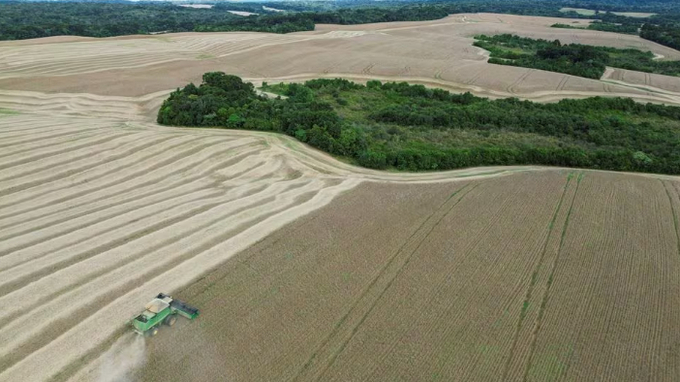November 28, 2025 | 03:46 GMT +7
November 28, 2025 | 03:46 GMT +7
Hotline: 0913.378.918
November 28, 2025 | 03:46 GMT +7
Hotline: 0913.378.918

Soybeans are harvested from a field in Ponta Grossa, Parana state, Brazil April 25, 2023.
Hot and dry weather in key Brazilian growing areas this season may have eliminated the top soybean exporter’s chance at a record crop, but have the estimates sunk too low, and does the market tend to overdo crop cuts at this early stage?
Some of the worst-case Brazilian estimates could drag South American soybean production very close to year-ago levels instead of the 13% rise that U.S. Department of Agriculture projections suggest.
But Brazil’s crop has a cushion in the wider market context given the expected pullback in Chinese demand, a thriving Argentine soy crop and a possible jump in U.S. soybean acres this spring, among other factors.
Both USDA and its Brazilian counterpart Conab made hefty cuts to their 2023-24 Brazilian soy crop pegs last week with USDA at 157 million metric tons and Conab at 155.3 million. Those compare with prior estimates of 161 million and 160.2 million tons, respectively.
But 135 million tons was floated this week by farm lobby Aprosoja, which said the extreme weather was being treated too lightly by other agencies. Another group, Patria Agronegocios, came in at 143.2 million tons last week.
It has been two years since Brazil’s soybean crop suffered serious downgrades. That year, Conab’s February reduction brought 2021-22 output close to final levels, though USDA did not make the appropriate move until March.
Scanning through other industry estimates from early 2022 suggests no one was critically low in January or February. But there are some differences between 2022 and 2024.
Before 2022, it was practically unfathomable that Brazil’s crop could tank so hard, but it is no longer a foreign concept. This season’s weather struggles have been well advertised since the start, whereas the 2022 ones started popping up toward late December.
The 2022 problems were focused in the later-harvesting south, though this year’s worries are prominent in the center-west, including in top grower Mato Grosso. The situation there is unprecedented in modern times, though southern states have had other difficult seasons recently.
Analytics group EarthDaily Agro on Wednesday suggested Mato Grosso’s soy yields would be the worst relative to trend in at least 15 years at 15% below. That is less severe than losses in recent seasons of more than 40% in southern states Parana and Rio Grande do Sul.
However, Mato Grosso plants about as many hectares of soybeans as those two states combined and it sows three times the amount of second-crop corn, which Brazil uses for exports. No. 2 soy grower Parana may be on watch as 64% of its bean crop is in good condition as of this week, down 22 percentage points so far this month.
With USDA’s current South American estimates, Brazilian soybean production would have to fall to 132 million tons in 2024 to prevent output from rising on the year across the continent’s four major producers. That does not include potential rises in Argentina’s crop, which was dubbed a “super harvest” by one of its grains exchanges this week.
But a 25 million-ton reduction in Brazil would require an easing in global soy demand estimates. USDA sees 2023-24 global soybean consumption up 5% on the year to a new record.
A demand slowdown may already be in store, as a recent downturn in China’s hog sector is expected to reduce first-quarter Chinese soybean imports to a four-year low. Analysts there believe China’s soy haul may expand only 2% this year despite a larger increase in the global soy harvest.
Fast-declining soymeal prices have destroyed margins for Chinese soybean crushers. Those margins have raced lower since the start of 2024 and are among the most negative ever recorded, which are not enticing for overseas soy purchases.
(Reuters)

(VAN) A new study reveals how the simultaneous effects of ocean acidification, salinity and loss of oxygen are making the world more fragile.

(VAN) Hopes are growing that the creation of the first 3D turkey gut model could be a turning point in the battle against the virulent blackhead disease.

(VAN) Tyson, America’s biggest meat supplier, plans to shutter one of its largest beef processing plants as the industry continues to struggle with low cattle supplies and political pressure from Washington.

(VAN) New FAO study shows how digital solutions are empowering farmers and fishers to prevent losses and build resilient agrifood systems.

(VAN) Brazil's COP30 presidency pushed through a compromise climate deal on Saturday that would boost finance for poor nations coping with global warming but that omitted any mention of the fossil fuels driving it.

(VAN) Poultry farmers in the UK have been warned that they could face one of the worst winters yet for bird flu.

(VAN) Prices of main-crop paddy have risen sharply, with jasmine rice hitting 16,100 baht per tonne — the highest level in years.